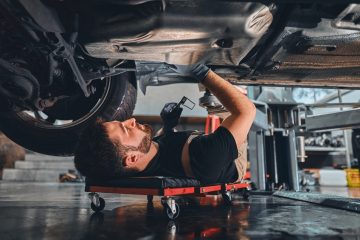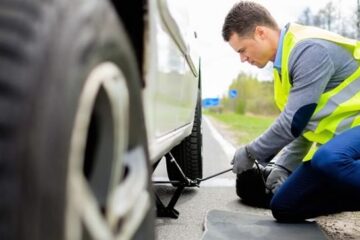Ever wondered how mobile mechanics keep themselves and their customers safe while working on cars in various locations? It’s a crucial question that often gets overlooked. But safety should always be the top priority in any mobile mechanic business.
I’ve been in the mobile mechanic game for over a decade, and I’ve seen my fair share of close calls. That’s why I’m passionate about sharing these safety tips with fellow mechanics and business owners.
Let’s dive into the world of mobile mechanic safety and explore how you can protect your business, your team, and your customers.
1. Train Your Team Like Your Business Depends on It (Because It Does)
Safety starts with proper training. You wouldn’t send a rookie quarterback into the Super Bowl without practice, right? The same goes for your mobile mechanics.
Here’s what you need to do:
- Create a comprehensive safety training program
- Cover everything from basic tool handling to complex repair procedures
- Include hands-on practice sessions
- Regularly update your training materials to stay current with industry standards
- Test your mechanics’ knowledge and skills periodically
Remember, a well-trained team is a safe team. And a safe team keeps your business running smoothly.
2. Gear Up: Personal Protective Equipment (PPE) is Non-Negotiable
Would you go skydiving without a parachute? Of course not! The same principle applies to PPE for mobile mechanics.
Essential PPE for mobile mechanics includes:
- Safety glasses to protect eyes from debris and chemicals
- Work gloves to guard against cuts and burns
- Steel-toed boots to shield feet from heavy parts and tools
- Ear protection for noisy environments
- High-visibility vests when working in low-light conditions
Make sure your team has access to quality PPE and knows how to use it properly. It’s not just about having the gear; it’s about using it consistently.
3. Keep Your Tools in Top Shape
You wouldn’t want a surgeon operating on you with rusty scalpels, would you? The same goes for your mechanics’ tools.
Follow these steps to maintain your tools:
- Regularly inspect all tools for wear and damage
- Replace or repair tools as needed
- Keep tools clean and properly stored
- Organize tools systematically for easy access and reduced clutter
- Train mechanics on proper tool use and maintenance
Remember, well-maintained tools not only improve safety but also boost efficiency and quality of work.
4. Create a Mobile Mechanic Safety Checklist
Checklists aren’t just for grocery shopping. They’re a powerful tool for ensuring safety in mobile mechanic operations.
Here’s what your safety checklist should include:
- Pre-job site inspection
- Vehicle assessment before starting work
- PPE verification
- Tool and equipment check
- Post-job cleanup and safety review
By following a checklist, you reduce the risk of overlooking crucial safety steps in the hustle and bustle of daily work.
5. Communication is Key: Establish Clear Safety Protocols
In the world of mobile mechanics, good communication can be the difference between a smooth job and a safety nightmare.
Implement these communication strategies:
- Create a clear chain of command for safety issues
- Establish emergency communication procedures
- Encourage open dialogue about safety concerns
- Regularly discuss safety topics in team meetings
- Use visual aids like safety posters in your mobile units
Remember, a team that talks openly about safety is more likely to practice it consistently.
6. Stay Up-to-Date with Safety Regulations
Safety regulations in the automotive industry change faster than fashion trends. It’s crucial to stay informed.
Here’s how to keep up:
- Subscribe to industry publications and newsletters
- Attend safety seminars and workshops
- Join professional associations for mobile mechanics
- Regularly review OSHA guidelines for automotive repair
- Implement changes promptly when new regulations are introduced
Staying current with regulations not only keeps your team safe but also protects your business from potential legal issues.
7. Implement a Job Hazard Analysis (JHA) System
A Job Hazard Analysis might sound fancy, but it’s simply a way to identify potential dangers before they become problems.
Here’s how to do a JHA:
- Break down each job into specific tasks
- Identify potential hazards for each task
- Develop strategies to eliminate or control these hazards
- Review and update your JHA regularly
- Involve your mechanics in the process – they often spot risks you might miss
By systematically analyzing job hazards, you create a safer work environment for your mobile mechanics.
8. Create an Emergency Response Plan
Hope for the best, but plan for the worst. That’s where an emergency response plan comes in.
Your plan should cover:
- First aid procedures
- Emergency contact information
- Evacuation routes (if working in a building)
- Fire safety measures
- Procedures for dealing with chemical spills
- Steps to take in case of severe weather
Make sure every team member knows this plan like the back of their hand. It could save a life one day.
9. Invest in Quality Equipment
You wouldn’t try to win a race with a broken-down car, right? The same principle applies to your mobile mechanic equipment.
Here’s what to focus on:
- Use high-quality diagnostic tools
- Invest in reliable lifts and jacks
- Maintain a well-stocked first aid kit in each mobile unit
- Consider adding safety features like backup cameras to your service vehicles
- Regularly update and replace equipment as needed
Remember, skimping on equipment quality can cost you more in the long run – both in terms of safety and efficiency.
10. Foster a Culture of Safety
Last but not least, creating a culture of safety is crucial. It’s not just about rules and regulations; it’s about making safety a core value of your business.
Here’s how to build a safety culture:
- Lead by example – always follow safety protocols yourself
- Recognize and reward safe behavior
- Address safety violations promptly and fairly
- Encourage reporting of near-misses and potential hazards
- Celebrate safety milestones as a team
A strong safety culture doesn’t just happen overnight. It takes consistent effort and commitment from everyone in the organization.
Real-Life Success Story: How Safety Saved the Day
Let me share a story from my own experience. A few years back, we had a new mechanic, Tom, join our team in Austin, Texas. He was eager to prove himself and often rushed through jobs.
One day, while working on a truck’s brakes, Tom forgot to wear his safety glasses. As he was removing a rusty bolt, it suddenly snapped, sending metal fragments flying. Thanks to our strict PPE policy, I caught this just in time and reminded Tom to put on his safety glasses.
Moments later, that same bolt shattered, and a piece ricocheted straight towards Tom’s face. His safety glasses stopped it cold. That near-miss was a wake-up call for Tom and reinforced the importance of our safety protocols for the entire team.
This incident turned Tom into one of our biggest safety advocates. It just goes to show how one close call can transform someone’s entire approach to workplace safety.
Frequently Asked Questions
- How often should mobile mechanics undergo safety training?
Safety training should be an ongoing process. Conduct formal training sessions at least annually, with monthly safety meetings to address specific issues or updates. New hires should receive comprehensive safety training before starting work.
- What are the most common safety hazards for mobile mechanics?
Common hazards include slips and falls, cuts from sharp tools or metal edges, burns from hot engine parts, chemical exposure, and injuries from lifting heavy components. Working in varying environments also presents unique challenges like uneven surfaces or poor lighting.
- How can mobile mechanics stay safe when working in extreme weather conditions?
For hot weather, stay hydrated, take regular breaks, and work in shaded areas when possible. In cold weather, wear appropriate clothing, use hand warmers, and be cautious of icy surfaces. Always have a weather-appropriate first aid kit and be prepared to reschedule jobs if conditions become too extreme.
- What should be included in a mobile mechanic’s first aid kit?
A mobile mechanic’s first aid kit should include bandages, gauze, antiseptic wipes, burn gel, eye wash, tweezers, scissors, disposable gloves, and a first aid manual. Also, consider including items specific to automotive work, like a chemical burn neutralizer.
- How can mobile mechanics protect themselves from chemical exposure?
Always wear appropriate PPE when handling chemicals, including gloves, safety glasses, and sometimes respiratory protection. Store chemicals properly in sealed containers and dispose of them according to regulations. Have material safety data sheets (MSDS) readily available for all chemicals used.
- What should a mobile mechanic do if they encounter an unsafe work environment at a customer’s location?
If a mobile mechanic encounters an unsafe work environment, they should politely explain the safety concerns to the customer and suggest alternatives. If the situation can’t be made safe, it’s better to reschedule or relocate the job rather than risk injury or property damage.
Safety in mobile mechanics isn’t just about following rules – it’s about creating a mindset where safety becomes second nature. By implementing these tips, you’re not just protecting your team and customers; you’re building a reputation as a responsible, trustworthy business.
Remember, in the world of mobile mechanics, safety isn’t just a priority – it’s a way of life. Stay safe out there, and keep those wheels turning!




